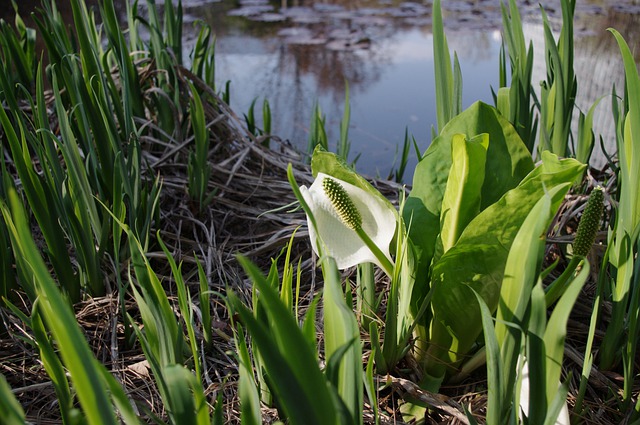Featured Photo by Chmee2 / CC BY 3.0
A field guide on how to identify & propagate Water Arum (Calla palustris), a perennial, water-loving plant hardy up to zone 2.

Hardiness Zone: 2-6

Soil Type: Clay, Loam, Sand.

Water: High, likes wet environments.

Exposure: Partial Shade
How to Identify Water Arum (Calla palustris)
Leaves

Water arum leaves are heart-shaped with entire margins and grow in basal arrangement.
The dimensions of a Calla palustris leaf can vary depending on the age of the leaf and the environmental conditions where the plant is growing.
Generally, the leaves are about 2-6 inches long and 1-2 inches wide.
Flowers

Calla palustris flowers are small, greenish-white that grow on a round spadix.
They grow on a long, slender stem that has a large, white, leaf-like elliptic spathe.
Flowering Season
Water Arum flowering season is typically from May to June.
Habitat
Calla palustris is a perennial plant that typically grows in wetland habitats, such as marshes, swamps, and bogs in the boreal forest.
It’s a plant native to North America, it grows in the majority of the Canadian provinces and some American States to the Northeast around the great lakes.
Here is the USDA Plants map describing its range.
Wildlife Value
The Calla palustris plant is not a significant source of food for any type of wildlife.
That’s because it contains calcium oxalate, which is toxic to animals and humans.
Although the flower does attract pollinators like bees and butterflies.
How to Propagate Water Arum (Calla palustris)
There are three good ways to propagate water arum plants: By germinating seeds, by dividing, and by taking cuttings.
- For the seeds, you’ll need to collect the fruit and extract the seed from the pulp.
- For cuttings, you’ll need to remove a stem with a leaf and give it the proper conditions to root.
- For division, it involves digging out a plant and splitting it into two halves.
Let’s look at the details of how to do it:
Propagate By Seed
To propagate water arum with seeds takes patience but it’s fairly low maintenance.
Water arum seeds should be picked when the fruits have dried off and turned yellowish-brown, which is later in the summer and during fall.

After you pick the seeds, they’ll need to go through a cold stratification period before they can germinate.
For cold stratification here’s what to do:
- Take a ziplock bag, tag it with the seed name and date, then fill 1/3 with sand.
- Next, add the seeds and moisten the sand, zip shut.
- Leave your seeds in your fridge for at least 90 days.
When you’ve given them time to cold-stratify, the next steps are easy enough.
- Pre-soak the seeds in water overnight.
- Fill a pot with moistened potting soil.
- Sow the seeds on the surface of the soil and press them in gently.
- Cover the pot with a plastic bag or glass jar to keep the soil moist.
- Place the pot in a warm location and keep the soil moist until the seeds germinate.
- Remove the covering once the seeds germinate and transplant the seedlings into a larger pot when they are big enough.
Water arum can take some time to germinate, it can take up to two weeks for the first sprouts to appear.
Propagate by Division
Another great way to propagate water arum plants is to divide them.
For division, you’ll need to find a healthy wild plant first. When you do, it’s simple enough, but you must be careful not to destroy the colony.
Here’s how to do it:
- Dig up the Calla palustris plants and divide them into clumps.
- Cut through the rhizomes (underground stems) with a sharp knife.
- Make sure each clump has at least one healthy rhizome.
- Replant the clumps in fresh soil.
Don’t put the divisions in direct sunlight for some time. They’ll be weakened and will need to strengthen in a partly shaded spot with plenty of moisture.
Propagate With Cuttings
It’s also possible to propagate water arum plants with cuttings.
You’ll just take a stem with a leaf, kind of like you would with a pothos plant.
Here’s how to do it:
- Cut a healthy stem from a Calla palustris plant with a sharp knife.
- Cut the top leaves significantly, almost down to 1/3. This will avoid moisture loss.
- Dip the cut end of the stem in rooting hormone powder, then knock off the excess with a light flick.
- Stick the stem in a closed container with a vented top, then fill it with potting soil, and water until it turns into a muck.
- Place the pot in a warm location, but away from direct sunlight.
- Keep the soil moist by watering it regularly.
- Roots will form in 2-4 weeks.
- Transplant the new plant into a larger pot when the roots are established.
When you’re ready to transplant, be careful. You should slowly acclimate the plant first since it’ll be used to a very moist environment.
Tilt the lid half off for a couple of days, then remove it for a few more days to acclimate it to the dry air.
FAQ
Q: Is Water Arum Edible?
A: Yes, but only a few parts, the rest of the plant is poisonous. Only the water arum berries are edible, as well as the cooked rhizome.
Q: Is Water Arum Poisonous?
A: Yes, water arum contains calcium oxalate, which acts as an oral irritant. It causes a burning sensation in the mouth, swelling, and difficulty swallowing. It can be very hazardous to dogs and cats when ingested.
Want to propagate plants like a pro? Check out our supreme guide on how to propagate plants.


